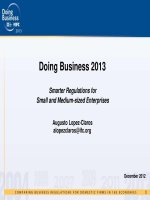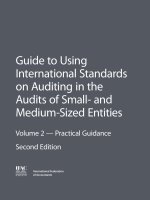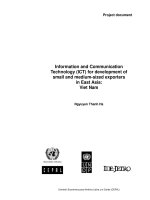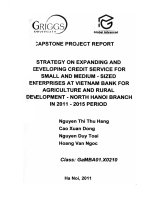Factors affecting the competitiveness of small and medium sized aquaculture enterprises in the north of vietnam
Bạn đang xem bản rút gọn của tài liệu. Xem và tải ngay bản đầy đủ của tài liệu tại đây (297.73 KB, 14 trang )
SUMMARIZING DISSERTATION
“FACTORS AFFECTING THE COMPETITIVENESS OF SMALL
AND MEDIUM SIZED AQUACULTURE ENTERPRISES IN THE
NORTH OF VIETNAM”
PREFACE
Market economy and international integration are creating many opportunities and
challenges for enterprises, especially the Small and Medium Sized Enterprises. So how
Vietnam’s Small and Medium Sized Enterprises should operate to survive and develop in a
competitive and integrative environment is now a major issue worth being paid great
attention to.
The study focused on factors affecting competitiveness of Small and Medium Sized
aquaculture Enterprises in the north of Vietnam. The study arose from the fact that to date
no study has been conducted to study the factors affecting competitiveness of SMEs in
aquaculture of Northern Vietnam. The Research utilized Both Primary and secondary Data.
The respondents in this study were members of board of directors at 122 small and medium
aquaculture enterprises of six coastal provinces in the North of Vietnam. Data for this
study was collected via email with director of aquaculture enterprises. The raw data was
analyzed. The study concluded that at the moment in the context of Vietnam there are some
factors affecting competitiveness of SMEs in aquaculture of Northern region. This includes
Financial Capability, Human Resources, Manufacturing equipment and technology
capability, Production capability, Management Capability, Marketing, R&D and Intangible
assets. The study also concluded that SMEs in aquaculture sector of QuangNinh province
has the highest competitive advantage of six coastal provinces in the Northern Vietnam.
However, the study also found out that the level of competitivenes of aquaculture
enterprises in the Northern Vietnam is identified at average level.
The study recommends some solutions to factors affecting the competitiveness of
aquaculture enterprises in the North of Vietnam. The report for this study is presented in
1
five chapters. Chapter one deals with introducing the concept and context of the study as
well as the purpose of the study. Chapter two gives the literature review while chapter three
explains how the research was designed. Chapter four gives the result and discussion.
Chapter five gives conclusion and recommendations.
CHAPTER I: INTRODUCTION
1. Background of the study
Market economy and international integration are creating many opportunities and
challenges for enterprises, especially the Small and Medium Sized Enterprises. So how
Vietnam’s Small and Medium Sized Enterprises should operate to survive and develop in a
competitive and integrative environment is now a major issue worth being paid great
attention to.
In recent years, Vietnam's economy in general, in particular aquaculture sector is in the
process of economic integration in the region and the world. This is also a great opportunity
for aquaculture enterprises in the North of Vietnam. However, aquaculture enterprises in
the North have met the big challenges such as fierce competition.
2. Statement of the problem
Aquaculture sector is strength of Vietnam and has now been identified as key economic
sectors of the country by the achievements that this sector has achieved in the past and
future prospects. Currently, the Northern region of Vietnam has 122 aquaculture enterprises
in six coastal provinces. Every year, the manufacturing aquatic sector brought considerable
income for the region and for the country.
Therefore, the author has chosen thesis “Factors affecting the competitiveness of
Small and Medium Sized aquiculture Enterprises in the north of Vietnam”. In this study,
the authors focus on identifying the factors that affect the competitive advantage of the
business between the aquaculture enterprises in the northern region to propose
recommendations to improve the capacity competition for them.
In order to achieve the aim of study, the researcher will have to answer the following
research question:
2
Which factor affects the competitiveness of the small and medium sized aquaculture
enterprises in the North of Vietnam, nowadays?
How is competitive level of aquaculture enterprises in the North of Vietnam
evaluated?
3. Significance of study
The results of this study are the picture of the factual situation of the Small and Medium
Sized Enterprises in aquiculture in the north of Vietnam. This study will identify factors
affecting the competitiveness of the small and medium sized enterprises in aquiculture,
especially in the north of Vietnam. The result of study will show some suitable solutions to
each factor that affecting the competitiveness of
aquaculture enterprises to meet the
circumstances and environment of stiff competitiveness in the Northern region of Viettnam.
4. Scope and limitations of the study
The research focuses on presenting the current situation of some aquiculture SMES in
the north of Vietnam. Beside that it determines factors for improving the competitiveness
of enterprises in aquiculture in the north of Vietnam.
It is limited to the factors cited in the study affecting the competitiveness of enterprises
in aquiculture in Vietnam and giving some solutions to improve the competitiveness of
small and medium sized enterprises in aquiculture in the future.
The study will be carried out in small and medium sized enterprises in aquiculture in six
coatstal provinces the north of Vietnam.
CHAPTER II: REVIEW OF RELATED LITERATURE AND STUDIES
1. Review of related studies
This section present of 29 literatures related to the topic.
2. Theoretical framwork
Main aspects of Porter’s five forces affecting competitiveness of enterprises
Value chain analysis can help the researcher understand the key strengths and
weaknesses of the enterprises and how the firm differs from its competitors.
The study adapted from David Aker’s model (2007) for analysing the factors impacting
competetiveness of enterprises. David Aker proposed a model to rank a business against its
competitors based on key success factors (KSF).
3
3. Conceptual framework
From theory and definition in section 2.1 and 2.2, the framework of this thesis the
author has focused on the micro factors affecting the competitiveness of small and medium
sized enterprises in aquaculture sector.
Group micro factors:
Financial Capability
Human Resources
Manufacturing equipment and technology capability
Production capability
Management Capability
Marketing
R&D
Intangible assets
CHAPTER III: METHODOLOGY
Research design
Based on the research objectives of the thesis, the author do research as following steps:
Clarify the factors affecting the competitiveness of Small and Medium Sized aquiculture
Enterprises in the north of Vietnam”; Study theory of competitiveness and the indicators
affecting the competetiveness; apply theoretical model to identify factors and different
impacting levels of these factors on the competitiveness of enterprises; analyze compare
the indecators impacting on the competetiveness of small and medium sized enterprises in
aquaculture industry; Quantitative research using multivariate regression models to
measure the impact of factors affecting the competitiveness of SMSEs in aquaculture of the
northen Vietnam. Data were analyzed by using statistical software SPSS .
The study adapted from David Aker’s model (2007) for analysing the factors impacting
competetiveness of enterprises. David Aker proposed a model to rank a business against its
competitors based on key success factors (KSF).
Source of competitive information and data
Both primary and secondary data are used in this study. Primary data are extracted from
a survey of 122
aquaculture enterprises in six provinces of the North of Vietnam.
4
Secondary data are sourced from various government agencies, a number of publications,
and industry associations.
This is a descriptive type of research that makes use of a survey questionnaire to
determine the factors that affect the competitiveness of aquaculture enterprises
Sample Size:
Author has taken investigation through questionnaire for all aquaculture enterprises in the
North of Vietnam. The questionnaire will be sent via email.
2. Description of research points
Measurement of the impact of eight factors on competetiveness between aquaculture
enterprise and provinces in the North of Vietnam : QuangNinh, HaiPHong, NamDinh,
ThaiBinh, NinhBinh and ThanhHoa.
A five-point Likert scale was used for the scoring indicators of 5 indicators. It is
including 5 scales: extremely low, low, neutral, high, extremely high
In order to analysis, the results obtained from the questionnaire were entered into SPSS
spreadsheet.
3. Research Instrument
The researcher will use a questionnaire and document analysis as the main instruments
for data gathering. The questionnaires shall contain items to be asked to respondents with
multi- choice questions.
Data gathering procedures
The study used both primary and secondary data to identify the factor affecting
competitiveness and access the level of competitiveness of aquaculture enterprises.
Primary Data Collection Method
Primary data was collected through a survey with 122 aquaculture enterprises in the
north of Vietnam. The survey was done in 5 weeks.
Secondary Data Collection Method
The data situation of aquaculture enterprises in the North of Vietnam is moderately
complicated by the fact that there are in fact two parallel data collection systems in
5
operation - one conducted by the sector itself, and the other managed and controlled by the
General Statistics Office (GSO).
4. Statistical analysis
- Comparative value method
- Frequency scale for 08 factors through indicators: financial capability, human resources,
manufacturing equipment and technology capability, production capability, management
capability, marketing, R&D and intangible assets which impact on competitiveness of
aquaculture enterprises in the North of Vietnam. It use Cronback'alpha method to evaluate
the reliability of the scale of the information collected;
- ANOVA was used to analyze differences of competitiveness between 06 provinces in
northern region.
CHAPTER IV: RESULTS AND DISCUSSION
1. Evaluating the reliability of statistic data
In order to evaluate the reliability of scale, the thesis uses coefficient of
Cronbach’alpha.
2. Analysis the indicators of the competitiveness between Small and Medium Sized
Aquaculture Enterprises of the six provinces in the North of Vietnam
1. Financial capability
-
QuangNinh: 20 enterprises (48.8%)
-
HaiPhong: 17 enterprises (41.5%)
-
NamDinh: 3 enterprises (7.3%)
-
ThanhHoa: 1 enterprise (2.4%)
-
The two remaining provinces of Ninh Binh ThaiBinh and There are no
enterprises in two this provinces are considered high.
2. Management Capability
Table 1: Number of companies assessed management capability of six provinces
6
3. Intangible assets
Figure 1: Number of enterprises having high rate of intangible assets
According to the survey, results showed that the number of enterprises in QuangNinh
has extremely high rate in intangible are 7 (accounting for 58,3%), in Haiphong province
there are 4 enterprises ( 33,3%), in ThaiBinh province there is only one (8,3%). Many
products of these enterprises are known not only in the domestic market but also in
international markets.
4. Manufacturing equipment and technology capability
Quangninh and Haiphong provinces have number of entterprises evaluated technology
and equipment at a good level is quite high (Quangninh now- 21 entterprises 32.8%;
7
Haiphong 24 enterprises accounting for 43.6%). However, the rest entterprises in four
provinces accounted for low rate. Even, there is no enterprise in Ninhbinh province.
5. Marketing
Figure 2: Market share of six province in 2012 in domestic market
7.00%
6.00%
5.00%
4.00%
3.00%
6.50%
5.30%
4.70%
2.00%
1.80%
1.00%
1.20%
1.60%
0.00%
Quang
Ninh
Hai
Phong
Nam
Dinh
Thai Binh
Ninh
Binh
Thanh
Hoa
This table above showed that in 2012 market share of QuangNinh province was the
highest at 6.5% and ThaiBinh is the lowest- only 1,2% in domestic market compared
between 6 provinces in the North of Vietnam.
(Source from VASEP- Annual report 2012 )
6
Production capability
At high rate of Production capability : there are 14 enterprise (22.2%) in QuangNinh;
26 enterprises in HaiPhong (41.3%), NamDinh has got 10 enterprises ( 15.9 %), ThaiBinh –
5 enterprises (7.9%), NinhBinh – 6( 9,5%) and ThanhHoa has only – 2( 3.2%).
7
Human Resources
8
Figure 3: Number of aquaculture enterprises is rated human resource in six provinces
surveyed at high rate
The result of the survey indicates that QuangNinh province has focused on human
development. It is very clear that there are three enterprises in QuangNinh are at extremely
high rate and 23 enterprises - at high rate. There are no ones at low and neutral rate.
8
Research and development
Research and developmen: QuangNinh provice
is the highest. There are two
enterprises in QuangNinh and HaiPhong has only one at extremly high rate whereas the
others (NamDinh,ThaiBinh, NinhBinh and ThanhHoa) has no one.
At
high rate of research and development: there are 24 enterprise (49.0%) in
QuangNinh;
15 enterprises in HaiPhong (30.6%), NamDinh has got 8 enterprises ( 16.3
%), ThaiBinh – 1 enterprises (2.0%), NinhBinh – 1( 2,0%) and ThanhHoa has no one (
0.0%).
3 The difference of competitiveness between provinces in Northern Vietnam in
aquaculture industry
According to evaluating eight indicators. : Financial Capability, intangible assets,
equipment, marketing, production capacity, the manpower, research and development. At
the 8 factors, competetiveness advantage of Quang Ninh province is different from the rest
five provinces in the northern region of Vietnam.
9
4 Evaluating the competitiveness of the aquaculture industry in the north of Vietnam
Based on the evaluation results in terms of 8 capacity’ factors of enterprises in the
provinces: Quangninh, HaiPhong, NamDinh, Thaibinh, Ninhbinh, Thanhhoa well as
differences in the competitiveness of these provinces we can see the whole picture of the
competitiveness advantage of the aquaculture sector in the Northern region. It is ranked at
the average rate. This shows that aquaculture sector in the Northern region of Vietnam has
to make many efforts to strengthen the competitiveness in today's environment in Vietnam
as well as in the world.
CHAPTER V: CONCLUSIONS AND RECOMMENDATIONS
1. CONCLUSIONS
The present study used theoretical approach of competativeness between small and
medium sized enterprises and statistical analysis and synthesis of competative indicators
of aquaculture sector in the North of Vietnam. According to results of Chapter 4 in this
thesis, the author conclude that:
For the Small and Medium Sized Enterprises in the field of aquaculture, the quality of
input factors still generates low rate of economic growth. Northern Vietnam’s Small and
Medium Sized Enterprises are still lagging far behind the bigger enterprises in the country
and the region in terms of capital, ability to get access to credit systems, standards of work
skills, work productivity, and technology in all phases are lack. All of these are challenges
to aquaculture enterprises in six coastal provinces of Northern Vietnam.
There are many factors which impact on the competitive advantage of aquaculture
enterprises in the North of Vietnam. The main indicators are financial capability, human
resources, manufacturing equipment and technology capability, production capability,
management capability, marketing, R&D and intangible assets. Among these factors,
human resources play very important role in creating competitive advantage for
development of aquaculture enterprises. In chapter IV, indicator of human resource is
evaluated at the highest value.
10
2. RECOMMENDATIONS
1- Financial Capability
- Attracting investments.
- Creating favourable conditions for the Small and Medium Sized Enterprises to get
access to official financial and credit sources.
2- Human Resources
- Technical workers operating in all basic areas of fisheries, such as exploiting, rearing,
preserving, and processing, all standardized.
- Management experts for economic research, approaching new knowledge and
management requirements.
- Scientists able to approach advanced science and technology and apply them immediately
in processing.
- Inspectors for controlling quality, food safety and hygiene; able to inspect and certify
quality of sea products under national standards and international standard.
- Set up international co-operation in training.
- Organize training courses inside the country and overseas to supplement aquaculture
Vietnam with management staff, researchers, and marketing staff to improve their skill and
knowledge.
3- Manufacturing equipment and technology capability
* Applying extensively the achievements of information technology
* Creating new products.
* Applying biotechnology, especially in technology of seedlings reproduction, feeds and
epidemic prevention.
*Continuing in-depth investment, innovation of technology and equipment; mechanize and
automate processing line by attracting foreign investment in order to rapidly approach
advanced processing technology of the world.
4- Production capability
11
- Build and efficiently carry out programs of developing products of high value,
- Focus on building and implementing strategies of product diversification,
- Push up the activities of product research,
- Upgrade working condition, apply management system of hygiene and food safety
according to HACCP, GMP, SSOP
- Build a system of quality standards
- Reorganize production.
- Strongly develop aquaculture to achieve high productivity,
- Improving productivity of exploitation, aquaculture, and processing will help reduce
expenses and increase profit margin
5- Management Capability
Reforming administrative procedures strengthen the reformation of administrative
procedures and improve the quality of public services to create favourable condition for
goods to pass customs at border gates.
Improve profession standard and responsibility of the managers who directly deal with
administrative procedures for enterprises.
6- Marketing
- Maintain and develop sea product market.
- Build a network for distributing Northern Vietnam’s sea products in other regions and
countries to actively regulate goods to bigger markets.
- Build business relationships with big distributors, supermarket chains, and food service
providers in bigger markets.
-
Improve methods of developing market towards specialization, diversification and
expansion of sales promotion.
-
Get commercialists and company staff to improve their knowledge standards of
international laws for international integration. Actively cope with conflicts and trade
barriers set by the importers.
7- R&D
12
- Product designing and listing
- The importance of the research and development of products is to aim the introduction of
product design, materials, features, new uses.
-
Conduct supporting activity to raise sales efficiency and increase prestige for
businesses.
-
Build and protect a business personality of each enterprise.
- Building and managing brand: Push up the building and managing of brand of each
product and the entire company.
13
Published works
1. Phan Thi Mai Huong. Fators affecting competitiveness of small and medium
aquaculture enterprises in the North of Vietnam. Corporate finance magazine. N0 4- 2013
pages 24-26, 2013
14









